This CE Center article is no longer eligible for receiving credits.
Over the past decade there has been a dramatic upswing in the number of companies that want to build reputations as good corporate citizens. Natural, organic, and sustainable are all highly desirable characteristics in the wide world of products. According to a 2009 study by accounting and consulting firm Deloitte Touche, 95 percent of shoppers would buy green provided they had the right information on an otherwise satisfactory item. But with the plethora of environmental claims by companies seeking to advance their products, "green," "eco friendly," "sustainable," and the likeare terms that have become confusing at best, meaningless at worst. In order to keep from drowning in greenwash, the market has demanded greater transparency and verifiable evidence of sustainable performance all along the supply chain.
This article will discuss how architects can be reasonably assured that products, particularly wood products, are maximally sustainable. Life Cycle Analysis (LCA) and forest certification will be discussed in terms of their place on an architect's sustainability agenda, and an LCA of western redcedar will be presented to demonstrate the level of research involved, along with results that can be expected from the life cycle approach.
Forest Certification
That wood is good is virtually a foregone conclusion. For thousands of years, wood has been used as a building material and the fact is, untreated wood has huge environmental benefits over other building products. It is completely biodegradable, works as an effective insulator, and is 100 percent renewable. Wood uses less energy to process than steel, concrete and aluminum. Wood products make up 47 percent of all raw material manufactured in the United States, but their share of manufacturing energy consumption is only 4 percent. Steel requires 21 times the energy to produce and releases more than 15 times the sulfur dioxide when compared to wood. Or, as Pritzker Prize winner Glenn Murcutt, one of Australia's most notable architects and May '09 AIA Gold Medalist put it, "One of the few sustainable materials is timber (wood). Steel and aluminum require more energy to produce. They should be used sparingly."
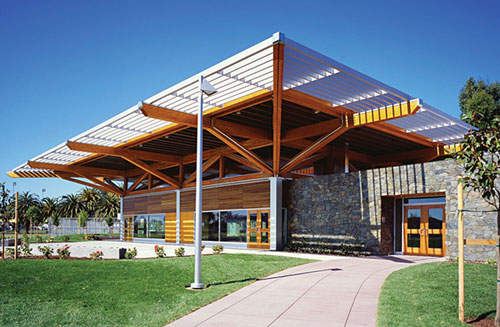 |
Western redcedar is one of the most prominent materials in the Orange Memorial Park, a San Francisco recreation center where sustainability was a key goal.
Photo: Mary Wong & Donn Logan Architects |
To ensure sustainability, wood products from certified forests should be specified, which admittedly is often a difficult and confusing task. According to MetaFore, a non-profit organization specializing in working with businesses to implement innovations relating to evaluating, selecting and manufacturing environmentally preferable wood and paper products, there are several certification systems relevant to the North American marketplace:
- The American Tree Farm System (ATFS) covers small, private, non-industrial landowners, typically family forest landowners. ATFS certifies contiguous parcels from 10 to 20,000 acres and was endorsed by PEFC in August of 2008.
- The Programme for the Endorsement of Forest Certification Schemes is a mutual recognition framework for national forest certification standards.
- The Canadian Standards Association is a national standard for sustainable forest management and tracking and labeling certified material. It covers operations in Canada. It is endorsed by PEFC.
- The Forest Stewardship Council is an international system covering forest management practices and the tracking and labeling of certified products and paper products with recycled content.
- The Sustainable Forestry Initiative® Program is a sustainable forest management standard targeting large industrial operations in Canada and the United States. It is endorsed by PEFC.
Environmental Impact |
Wood |
Steel |
Concrete |
Total Energy Use |
Lowest |
140% more |
70% more |
Greenhouse Gases |
Lowest |
45% more |
81% more |
Air Pollution |
Lowest |
42% more |
67% mor |
Water Pollution |
Lowest |
1900% more |
90% more |
Solid Waste |
Lowest |
36% more |
96% more |
Ecological Resource Use |
Lowest |
16% more |
97% more |
| Source: Athena Institute,www.athenasmi.org |
Â
Additionally, forest certification systems are emerging in Asia, Australia and South America. In developing countries in these areas, many forest managers lack the capacity to undergo a certification audit and maintain operations to a certification standard, and are working toward certifying operations in a gradual approach.
While certification is intended to enhance forest management practices around the world, most certified forestry operations are located in Europe and North America. A 2006 independent analysis by the UK government of the above-mentioned certification systems (except for ATFS) indicated that these systems do indeed harvest wood sustainably and legally. Jack Draper, Managing Director of the Western Red Cedar Lumber Association, advises architects interested in specifying certified wood products to obtain lumber from one of the respected certifying bodies. "With 90 percent of the world's forests uncertified, what's important is making sure your forest product is independently certified," he says. "We're strong supporters of third party certification - and some certification is far better than no certification at all."
 |
Knotty western redcedar siding is featured on Columbia Sportswear retail outlets.
Photo: Ben Schneider |
Architects are increasingly making the effort to specify certified wood, and it's showing up on many award-winning projects. The Queens Botanical Garden's Visitors' Center, New York City's first public LEED® Platinum-certified building, incorporated FSC-certified western redcedar. Designed by New York City-based BKSK architects as a nexus of botanical and cultural exploration for one of the most ethnically diverse neighborhoods in Queens County, the center was envisioned as an extension of the garden's mission to demonstrate environmental stewardship while celebrating the connections between people and plants. The Center is composed of a forecourt and dramatic roof canopy, a central reception and administration building clad in western redcedar, and an auditorium space tucked into the landscape itself, sheltered by a sloping green roof. BKSK chose western redcedar for both performance and aesthetic characteristics: durable and stable, cedar will naturally weather over time, reflecting the passage of seasons in the surrounding garden landscape.
Western redcedar from sustainably managed forests in British Columbia was used by Grimshaw Architects in designing the Experimental Media and Performing Arts Center at Rensselaer Polytechnic Institute in Troy, New York. The center is a laboratory for both performing arts and science and provides state-of-the-art immersive environments for the senses of seeing and hearing including a concert hall, a theater, three performance studios and recording and editing facilities. The concert hall is the centerpiece of the building and is contained inside an enormous three-dimensionally curved wooden "hull," clad entirely in western redcedar tongue-and-groove planks, selected for superior technical performance characteristics in addition to esthetic qualities. The hull was subjected to a stringent series of flame spread tests and the cedar was judged to inherently conform to the Class B rating required, including the applied finish which met with the architect's demanding and diverse requirements.
 |
Western redcedar from sustainably managed British Columbian forests was part of the environmental profile at RPI's the Experimental Media and Performing Arts Center.
Photo: Grimshaw Architects |
Life Cycle Analysis:Â The Basics
Getting to green can be perplexing, especially as manufacturers may only promote certain attributes of their products, keeping mum on their more questionable environmental impacts. Advertising may tout the fact that a product may be biodegradable or contain recycled content, for example, while its high degree of embodied energy or emissions goes unmentioned. In view of the challenges involved in getting to the truth about a product's true environmental picture, many companies have enlisted the support of the Life Cycle Analysis (LCA) to back up their sustainability claims. Also known as life cycle assessment, ecobalance, and cradle-to-grave analysis, the LCA is a decision making tool. It acknowledges that all phases of a product's life, from cradle to grave, have an impact on the environment and these impacts can be quantified and compared. The LCA assesses those impacts from the time materials are extracted through manufacture, transportation, storage, use, recovery, reuse and disposal.
The1970s global modeling studies and energy audits that sought to evaluate resource cost and environmental implications of different patterns of actions were the forerunners of life cycle assessments and analysis. The LCA approach really took shape in the 1980s, though for many years was mainly popular in Europe. Now the LCA is gaining traction in North America as companies look to give teeth to their environmental claims or pinpoint where in the cradle-to-grave process their environmental liabilities are most prevalent. In many industries, LCAs are becoming crucial to the support of ecolabelling, as awarding authorities must rely on a scientific method of evaluating the manufacturing processes involved, the energy consumption in manufacture and use, and the amount and type of waste generated.
Generally speaking, there are four stages of an LCA:
Goal and Scope Definition. Goals, system boundaries and intended uses are established.
Life Cycle Inventory. A data-based quantification of energy and raw material requirements, air emissions, waterborne effluents, solid waste and other environmental releases through the life of a product or process.
Life Cycle Impact Assessment. An evaluation of the effects of the environmental information collected in the inventory. A full impact assessment addresses ecological and human health, as well as the range of social, cultural and economic effects.
Life Cycle Improvement Analysis. Identification of areas where environmental impacts can be reduced or mitigated within the life cycle of the product or processes.
| Life Cycle Assessment Framework |
 |
LCA versus Prescriptive Standards
People make environmental decisions all the time…paper towels over cloth…plastic bags over paper. Many are intuitive decisions. So it is with the building industry in looking for guidance to achieve green standards. However, many green standards in use - bamboo floors, bike racks, steel framing vs. wood framing, for example - are just as intuitively based, without regard for their total energy implications or greenhouse gas emission. Because it is a protocol-based scientific methodology that measures energy, raw material and other manufacturing inputs as well as wastes, emissions, use and disposal, the LCA is a more comprehensive approach to indicating a product's green quotient.
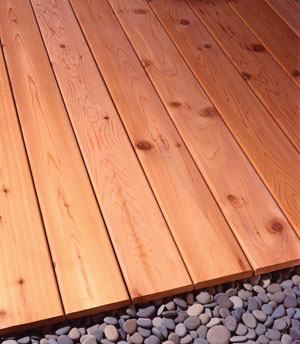 |
Western redcedar is carbon neutral.
Photo: Western Red Cedar Lumber Association |
In a 2008 report entitled "Green Building Programs in the United States: A Review of Recent Changes Related to Designation of Environmentally Preferable Materials," Dr. Jim Bowyer and Alison Lindburg of Dovetail Partners, Inc., concluded that "critical issues related to designation of environmentally preferable construction materials remain unaddressed in most green building programs." The authors went on to say that "variability in the standards is causing confusion, and proliferation of scientifically unsubstantiated prescriptive standards is occurring as new programs are developed and existing programs are revised. Despite the strong adoption rate for green building programs, there is much room for improvement and work needs to be done to reach the goal of ensuring that programs truly result in improved environmental performance. To this end, expanded adoption of life cycle assessment for identification of environmentally preferable materials is essential."
Wayne Trusty, President of the Athena Institute, a non-profit organization that seeks to improve the sustainability of the built environment through better information and tools, adds: "Prescriptive standards are attribute oriented. To assume that something like rapid renewables are green just because they grow quickly, without considering factors like water, energy or fertilizer usage is misleading. It's presumptuous to think that rapid renewables are automatically better or to make them part of an environmental code. The LCA, as opposed to prescriptive standards, gets at the full range of a product's implications, and that is important information."
LCA Concerns
LCAs are recognized around the world as one of the most effective analytic tools for estimating the sustainability profile of a product or service. But not all LCAs are created equal. There are several areas that architects will want to pay particular attention to in determining the credibility of an LCA.
Data. An LCA is heavily data dependent and in the end will be only as valid as its input. Obviously, data should be as accurate and up to date as possible. While this can be particularly challenging as new processes, manufacturing methods and materials are being introduced constantly, using old data will invalidate the quantitative analysis and inaccurately reflect the product's environmental profile. In some instances data will be hard to obtain, particularly pproprietary or commercially-sensitive raw data or information indicating that a company's product is in any way inferior to a competitor's product.
Interpretation. Challenges increase in this second stage, life cycle assessment, as it involves interpretation of the data, and that requires value judgments to be made. Difficult decisions are routine here - is heavy energy demand less burdensome than heavy water use, for instance, or how utilizing non-renewable mineral resources like oil or gas stand up to the production of softwoods for paper. Skeptics also voice the concern that while an LCA may be able to characterize the effect of a product on global warming, it is less clear when it comes to what the effect will be on human health or the integrity of ecosystems.
Comparisons. In comparing the life cycle analyses of two different products if the same level of data, both quantity and quality, are not available for both products, the findings will be flawed. Comparisons are rarely easy because of the different assumptions that are required - even evaluating two same-size items that were identically distributed and recycled, though seemingly simple, will require a number of assumptions. For example, something as apparently straightforward as assessing the impacts of truck transportation to deliver a product will necessitate judgments about the truck's size, condition, route, and speed, any of which might have significant bearing on the outcome of the analysis. When it comes to making life cycle comparisons of different products, considerably more and greater judgments and assumptions will be called into play.
Yet when reliable, high-quality data is available, the boundary of the study has been clearly defined and the methodology rigorously applied, the LCA can yield valuable results that increase environmental transparency. Experts maintain that the most rigorous approach is an LCA conducted according to the International Organization for Standardization (ISO) 14000 series, a family of standards that addresses environmental management, and the actions of the organization in question to minimize harmful effects on the environment caused by its activities, and to achieve continual improvement of its environmental performance. According to Athena's Trusty, ISO 14044 is the main standard for LCAs, with ISO 21930 standards providing a more detailed specification for building materials and, on the horizon, ISO 21931 that will form the basis of an LCA at the level of the whole building-an amalgam of its constituent parts.
"There is noise in the system, especially from industries that LCA is perceived to affect negatively, with consequent arguments that it is not quite ready for prime time," says Trusty. "But it's an evolving process, and currently there are many things being done on a national and international level to create databases that will reduce uncertainties in the LCA process."
 "Every product will have some impact on the environment," says Draper. "What the LCA will do is to identify those products that use more resources, generate more pollution, waste or other unfavorable impacts than others, and in that way distinguish the products that are harmful from those that are reasonably environmentally sound. Manufacturers must identify the environmental footprint of their products. Currently, the best way to accomplish this is through an ISO-compliant LCA - that's the gold standard." Draper also notes as greenwash continues to proliferate and prescriptive standards unlikely to consistently lead the way to verifiable green standards, architects interested in specifying wood building materials that are sustainable may have a relatively clear-cut path. "In terms of specifying wood products, with forest certification and a favorable ISO-compliant life cycle analysis,
you are well on your way to specifying a bona fide green product," says Draper.
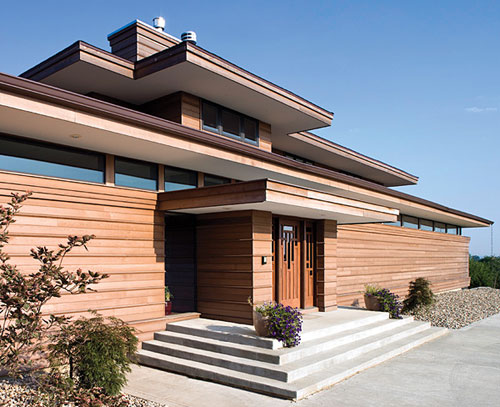 |
BRE, a UK-based independent and impartial research-based consultancy, testing and training organization, gave wall systems with western redcedar
its top rating of A+ in its "Green Guide to Specification."
Photo: Western Red Cedar Lumber Association |
Â
Western Redcedar Life Cycle Analysis
Western redcedar is one of the world's most thoroughly researched woods. A common tree in the Pacific Northwest coastal and interior rainforests of British Columbia, western redcedar is one of the longest lived and most decay- and insect-resistant softwood species in North America. It is light in weight, uniformly textured, straight-grained and contains no resin.
Western redcedar produces fewer greenhouse gases, generates less water and air pollution, requires less energy to produce than alternatives and comes from a renewable and sustainable resource. Equally important, western redcedar is carbon neutral. These assertions are borne out scientifically in the third-party LCA of siding and decking products commissioned by the Western redcedar Lumber Association (WRCLA) which determined that course to be the only credible way to provide consumers with reliable environmental performance information.
To place the study results in sharper perspective, a parallel study of alternative products including brick and fiber cement siding as well as composite decking products was also commissioned. FPInnovations, Canada's leading forest products research organization, conducted the study in accordance with international standards in the ISO 14040/44 series, which requires that all products be treated equally and be of similar quality. Study results were presented for peer review to independent third-party organizations to ensure ISO standards compliance.
For western redcedar products, the study was based on data obtained from a representative cross section of cedar mills in British Columbia and Washington state in 2007. The Athena Institute provided life cycle inventories (LCIs) for clay brick, fiber cement and vinyl siding. Cradle-to-grave LCIs for wood-plastic composite decking made with either virgin or reprocessed plastic were also developed using secondary data sources as well as information collected from experts in the petrochemical and wood-plastic composite fields.
In order to evaluate the environmental impacts of the life-cycle stages of product alternatives, the life cycle was modeled as four distinct life-cycle stages: resource extraction and manufacturing, transportation to customer, installation and use, and end-of-life disposition - an approach that helps identify where environmental contributions occur within the life cycle of each product system.
Summary of Decking and Siding Findings
In comparing western redcedar decking and siding to alterative building materials, environmental impact measures were applied consistently to each product and included: total primary energy on a cumulative demand basis, global warming potential, acidification potential, aquatic eutrophication potential, ozone depletion, smog formation potential, and human particulate (respiratory) effects.
In the study's main finding, western redcedar decking substantially outperformed composite decking in each of the seven criteria tested and was by far the product with the least environmental impact when compared with both virgin and recycled wood-plastic composite (WPC) decking products. "The seven impact measures tested typically represent a product's environmental footprint, and the findings are consistent with dozens of other LCAs that evaluated wood against other building materials," says Jennifer O'Connor, Group Leader, Energy & Environment Building Systems Program FPInnovations, Forintek Division.
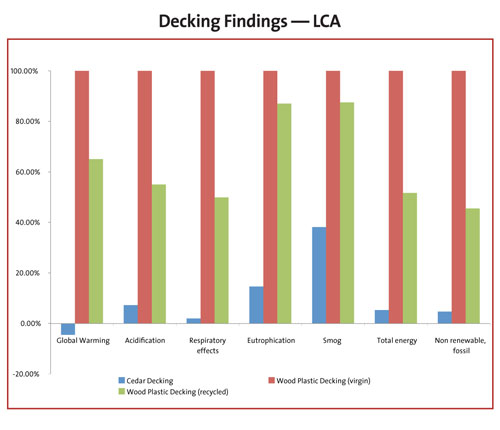
Other key findings include the following:
- Even after subjecting the cedar decking results to a "worst case" scenario in which western redcedar required the replacement of 20 percent of boards in normal service and periodic application of coatings, the environmental impact results remained strongly in favor of western redcedar over a "best case" scenario for composite decking.
- Western redcedar siding had the best overall performance when compared to vinyl and fiber-cement and brick. The western redcedar received top marks in five of seven impact criteria, including "global warming potential."
- In the case of decking, western redcedar substantially outperforms WPC, regardless of the recycled plastic content in the WPC, across all the environmental metrics examined in the study.
- Western redcedar siding impact on smog and eutrophication - the criteria in which it was not the leader - can be traced directly to the use of paint, not the natural characteristics of cedar. Use of high quality paints and stains (some of which carry performance warranties) or the use of the new water-borne coatings would have a very positive impact on results.
- Total life energy of western redcedar siding can be further improved by altering end-of-life disposal practices away from the assumed practice of 100 percent landfill, to a mix of reuse, energy recovery and landfilling. While other products tested remained green house gas contributors, reusing the cedar results in the wood becoming a net "carbon sink." That practice is already reality in many communities and on high-profile projects.
Philadelphia-based architecture firm KieranTimberlake used reclaimed western redcedar on two recent award-winning projects: the Stewart Middle School at Sidwell Friends School and the Yale School of Art Gallery. At Sidwell Friends, the firm's addition and renovation transforms the 55-year-old school into a teacher of environmental responsibility by example. The exterior is western redcedar obtained from 100-year-old wine vats, which allowed for design flexibility that could not be obtained with other materials, and allowed architects to manipulate the façade for solar shading on the eastern and western sides and unify new and existing structures. Vertical plank fins are angled so that daylight penetrates deep into the building while protecting against solar gain.
Reclaimed western redcedar was also used at the Yale School of Art Gallery. Located at the end of a row of two-story 19th century houses, the school is a taut wood box with side walls that subtly bow out, scaled to fit the New Haven streetscape. The exterior wall is a ventilated wood rain screen made of horizontal strips of reclaimed western redcedar beveled on the top and bottom edges to divert water to drain to the outside. The strips are spaced 1/8 inch apart for air circulation, allowing the cladding to expand when wet and dry evenly on both sides. This layered wall construction creates a lattice-like scrim at the entry and a pattern of parted planes at the corners of the building. The gallery entrance is set within a recessed glass enclosure along the north end of the building, where an open screen of spaced western redcedar slats is suspended veil-like from the roof.
 |
 |
KieranTimberlake used reclaimed wood from century-old wine casks to boost the sustainability quotient at two award-winning projects.
Top: Sidwell Friends Middle School
Bottom:The gallery at the Yale University School of Art
Photos: KieranTimberlake |
Â
The firm's research states that western redcedar is "a dimensionally stable ‘small movement,' and highly weather resistant wood. Its characteristics have made it the most popular wood for cladding in North America over several centuries." According to Chris Macneal, Senior Associate at KieranTimberlake, the main issue with western redcedar was how it would weather. Western redcedar, Macneal says, has an attractive weathering progression from its fresh-cut red-brown through to silver gray that is dependent on its exposure to sunlight, rain, condensation, and whether it's protected by an overhang- factors that were extensively discussed with clients on both projects. "A lot can be done through careful detailing of the façade to make weathering as uniform as possible," says Macneal, noting that generally the better ventilated the cedar, the more uniform the weathering.

Presupposing predictable appearance and careful detailing, KieranTimberlake's life cycle thinking supported the decision to go with untreated cedar cladding. "In widths we were applying the western redcedar, 3/4 and 5/4 inches, and with little or no maintenance, we anticipate an 80-year solution," says Macneal. "That's very good for wood cladding."
Increasing Validity of Comparison Analysis
There were many challenges involved in leveling the LCA comparison analyses of different products. According to FPInnovation's O'Connor, to increase the validity of the comparisons, a sensitivity analysis was performed to test the influence of various assumptions and to provide "what-if" scenarios that might change the relative performance of the decking alternatives. "When comparing one product to another it is particularly important to do a peer review, to make sure you're coming from a neutral place," says O'Connor. "You want to give the other products the benefit of the doubt to the extent possible and present the information in a way that is credible and transparent."
Specifically, in the western redcedar LCA, additional burdens were added to the cedar base case in the form of a regular regime of staining and board replacement, while removing environmental liabilities from the WPC scenarios, notably using a higher wood-to-plastic ratio in the formulation and shifting to partial biomass for production energy. Yet even in this cedar-worst-case comparison to WPC best-case, western redcedar still outperformed WPC alternates, although the WPC profiles are improved with those two changes. The LCA also compared the two WPC formulations finding that, as might be expected, manufacturing this product with recycled plastic substantially improves the environmental profile over a virgin plastic composite.
The analysis also found environmental burdens with western redcedar siding that were not experienced with western redcedar decking. The siding carries two additional burdens not shared with the decking: kiln-drying and painting. These activities have significant environmental impact, somewhat leveling the comparative field among competing siding products, the LCA found. However, western redcedar remains a strong performer in global warming impact, energy use (particularly in fossil fuel), acidification and respiratory effects. The impact of western redcedar siding in smog and eutrophication can be traced to paint, and the environmental results are sensitive to frequency of painting.
In general, brick is the worst performer in the base case, followed by fiber cement. However, the profile of brick is improved with a longer service life, meaning that bricks must be recovered for reuse if buildings are demolished within 200 years. This puts brick ahead of fiber cement in a case where brick has a 200 year service life and all other products are in their worst case scenario (more frequent painting for wood and fiber cement, and a reduced service life for vinyl). In the base case, western redcedar and vinyl perform similarly in several metrics, and this does not substantially change even in a worst case if more frequent painting for western redcedar. In a western redcedar best case (improved end-of-life situation), it stands out more substantially against the other products.
Towards Increased Product Sustainability
Used properly, an LCA encourages preventative and proactive environmental management. A key benefit of LCAs even for products with relatively few environmental impacts is that it identifies which stages have the potential to cause pollution and which have excessive heavy material or energy demands, or other environmental liabilities. The finely detailed breakdown of the manufacturing process can also point up where more sustainable products could be substituted. "With an LCA, a manufacturer can see if a change in the process has the potential to improve the overall numbers," she says. "We all want to make the right choices, but those choices are better made on the basis of analysis, than on what we assume to be ‘green.'"
The study recommended a number of actions that could lead to further improvements in the environmental profile of cedar products:
- More use of mill wood waste or by-products as an energy substitute for fossil fuel in the mill.
- The use of rail transport over trucks when transporting cedar products long distances.
- The use of paints or other coatings with a better environmental profile than current coatings and/or with better durability such that repainting is required less frequently.
- The elimination of painting or coating cedar products at all.
- The capture of cedar products at end-of-life for reuse, recycling or conversion to energy in place of landfilling.
Draper points to improvements in several areas that have already taken place or are in the process, beginning with better use of residual waste at the mill. "Technology has advanced so that manufacturers are able to use 100 percent of the tree product, with waste material going to produce biofuel for the drying process," he says. Draper also says that thanks to nanotechnology, water-based coatings last longer and consequently do not have to be applied as often. "We also have a much better understanding of disposal, and are moving away from the total landfill situation which has obvious deficits in terms of emission of methane gas, to a mix of recycling and reuse to enable net carbon sink. That's a real environmental benefit that no other building material can claim. There's always more work to be done, though, and the industry will continue to improve its practices working towards sustainable goals."
Purchases that Lighten the Environmental Footprint
These days, people - both as consumers and business professionals - are interested in learning how to live in a way that puts less pressure on the planet. There is increasing interest in choosing products that are gentle on the environment and reduce waste. Choosing building materials wisely is one way architects can make an
appreciable difference. To that end, it is important to support responsible producers that: harvest legally; regenerate promptly; decrease waste and promote recovery and recycling of products; reduce greenhouse gases and fight climate change; and welcome outside scrutiny of how they manage their forests.
"Architects who specify from producers that subscribe to this agenda will be lightening the environmental footprint for all of us," says Draper. Â
Clear Western redcedar Graces
Vistor Center at Grand Teton National Park |
Bohlin Cywinski Jackson Architects used substantial amounts of wood in the Craig Thomas Discovery and Visitor Center Grand Teton National Park in Moose, Wyoming to pay homage to the strong rustic architecture in the national parks while remaining fully modern in its design, execution and interpretive mission. The firm selected clear western redcedar for its warmth and rustic nature and used it throughout the interior as wall panels and casework. The building exterior evokes historic National Park architecture and the materials were selected for durability in an alpine climate. The clear western redcedar siding, board-formed concrete walls and wainscot and Douglas fir log columns will weather naturally and complement the colors and patterns of the Wyoming landscape. At the courtyard, the western redcedar siding is protected by deep roof overhangs and will retain its rich, warm color to welcome visitors to the facility. |
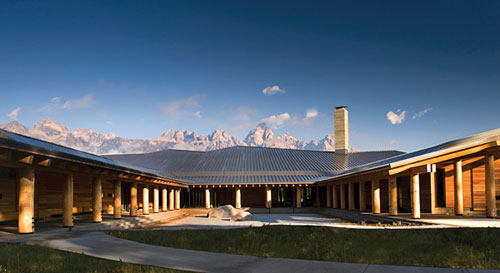 |
| Photo: Bohlin Cywinski Jackson Architects |
Â
 |
The Western Red Cedar Lumber Association represents Western redcedar producers, distributors and retailers throughout North America. The association offers extensive resources to assist with the selection, specification and application of a wide range of Western Redcedar products.www.wrcla.org. |
|





















